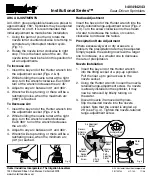
Sorting and Reading Resistors:
The electrical value of resistors is indicated by a color code (shown
below). You don't have to memorize this code to work with resistors, but
you do need to understand how it works:
1st Digit
2nd Digit
Multiplier
Tolerence
Black = 0 (tens)
Brown = 1 (hundreds)
Red = 2 (K)
Orange = 3 (10K)
Yellow = 4 (100K)
Green = 5 (1Meg)
Blue = 6
Violet = 7
Gray = 8
White = 9
Silver = 10%
Gold = 5%
Resistor Color Code
(gold or silver)
When you look at a resistor, check its multiplier code first. Any resistor
with a black multiplier band falls between 10 and 99 ohms in value.
Brown designates a value between 100 and 999 ohms. Red indicates a
value from 1000 to 9999 ohms, which is also expressed as 1.0K to 9.9K.
An orange multiplier band designates 10K to 99K, etc. To sort and
inventory resistors, first separate them into groups by multiplier band
(make a pile of 10s, 100s, Ks, 10Ks, etc.). Next, sort each group by
specific value (1K, 2.2K, 4.7K, etc.). This procedure makes the inventory
easier, and also makes locating specific parts more convenient later on
during construction. Some builders find it especially helpful to arrange
resistors in ascending order along a strip of double-sided tape.
Some VEC kits may contain molded chokes which appear, at first glance,
similar to resistors in both shape and band marking. However, a closer
look will enable you to differentiate between the two--chokes are
generally larger in diameter and fatter at the ends than resistors. When
doing your inventory, separate out any chokes and consult the parts list
for specific color-code information.
Reading Capacitors:
Unlike resistors, capacitors no longer use a color code for value
identification. Instead, the value, or a 3-number code, is printed on the
body.








































